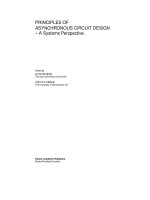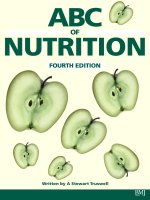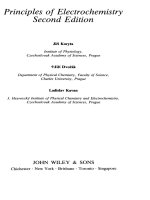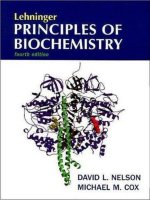Physicochemical principles of pharmacy fourth edition a t florence, david attwood
Bạn đang xem bản rút gọn của tài liệu. Xem và tải ngay bản đầy đủ của tài liệu tại đây (27.9 MB, 513 trang )
01_1439PP_FM
16/11/05
11:31
Page i
Physicochemical Principles
of Pharmacy
01_1439PP_FM
16/11/05
11:31
Page ii
01_1439PP_FM
16/11/05
11:31
Page iii
Physicochemical Principles
of Pharmacy
FOURTH EDITION
Alexander T Florence
CBE, DSc, FRSC, FRSE, FRPharmS
School of Pharmacy, University of London, UK
David Attwood
PhD, DSc, CChem FRSC
School of Pharmacy and Pharmaceutical Sciences
University of Manchester, UK
London
●
Chicago
01_1439PP_FM
16/11/05
11:31
Page iv
Published by the Pharmaceutical Press
Publications division of the Royal Pharmaceutical Society of Great Britain
1 Lambeth High Street, London SE1 7JN, UK
100 South Atkinson Road, Suite 206, Grayslake, IL 60030–7820, USA
© Pharmaceutical Press 2006
is a trade mark of Pharmaceutical Press
First, second and third editions published by Palgrave
(formerly Macmillan Press Ltd) 1981, 1988, 1998
Third edition reprinted 2004, 2005
Fourth edition 2006
Typeset by MCS Publishing Services Ltd, Salisbury, Wiltshire
Printed in Great Britain by Butler & Tanner, Frome, Somerset
ISBN 0 85369 608 X
All rights reserved. No part of this publication may be
reproduced, stored in a retrieval system, or transmitted in any
form or by any means, without the prior written permission
of the copyright holder.
The publisher makes no representation, express or implied,
with regard to the accuracy of the information contained in
this book and cannot accept any legal responsibility or
liability for any errors or omissions that may be made.
A catalogue record for this book is available from the British Library
Cover image: Polarised light micrograph of liquid crystals.
Magnification "100 at 35 mm size. Reproduced with permission
from James Bell Science Photo Library.
02_1439PP_CON
9/11/05
10:27 pm
Page v
Contents
Preface xv
Acknowledgements xvii
About the authors xix
Introduction
1
1
7
Solids
1.1
1.2
Crystal structure 8
Crystal form 10
1.2.1 Crystallisation and factors affecting crystal form 11
1.3 Polymorphism 13
1.3.1 Pharmaceutical implications of polymorphism 16
1.4 Crystal hydrates 19
1.4.1 Pharmaceutical consequences of solvate formation 20
1.5 Dissolution of solid drugs 22
1.6 Biopharmaceutical importance of particle size 23
1.7 Wetting of powders 26
1.7.1 Contact angle and wettability of solid surfaces 27
1.7.2 Wettability of powders 27
1.8 Solid dispersions 28
1.8.1 Eutectics and drug identification 30
Summary 31
References 32
2
Gases and volatile agents
2.1
2.2
Pressure units 36
Ideal and nonideal gases 36
35
02_1439PP_CON
9/11/05
10:27 pm
Page vi
Contents
vi
2.3
Vapour pressure 37
2.3.1 Vapour pressure and solution composition: Raoult’s law 37
2.3.2 Variation of vapour pressure with temperature: Clausius–Clapeyron
equation 40
2.3.3 Vapour pressure lowering 43
2.4 Solubility of gases in liquids 46
2.4.1 Effect of temperature on solubility 46
2.4.2 Effect of pressure on solubility 46
2.4.3 The solubility of volatile anaesthetics in oil 48
2.5 The solubility of gases in blood and tissues 49
2.5.1 The solubility of oxygen in the blood 49
2.5.2 The solubility of anaesthetic gases in blood and tissues 50
Summary 53
References 54
3
Physicochemical properties of drugs in solution
3.1
3.2
3.3
3.4
3.5
Concentration units 56
3.1.1 Weight concentration 56
3.1.2 Molarity and molality 56
3.1.3 Milliequivalents 56
3.1.4 Mole fraction 57
Thermodynamics – a brief introduction 57
3.2.1 Energy 57
3.2.2 Enthalpy 58
3.2.3 Entropy 58
3.2.4 Free energy 60
Activity and chemical potential 62
3.3.1 Activity and standard states 62
3.3.2 Activity of ionised drugs 63
3.3.3 Solvent activity 65
3.3.4 Chemical potential 66
Osmotic properties of drug solutions 69
3.4.1 Osmotic pressure 69
3.4.2 Osmolality and osmolarity 69
3.4.3 Clinical relevance of osmotic effects 70
3.4.4 Preparation of isotonic solution 73
Ionisation of drugs in solution 75
3.5.1 Dissociation of weakly acidic and basic drugs and their salts 75
55
02_1439PP_CON
9/11/05
10:27 pm
Page vii
Contents
vii
3.5.2
The effect of pH on the ionisation of weakly acidic or basic drugs
and their salts 77
3.5.3 Ionisation of amphoteric drugs 82
3.5.4 Ionisation of polyprotic drugs 83
3.5.5 Microdissociation constants 84
3.5.6 pKa values of proteins 85
3.5.7 Calculation of the pH of drug solutions 85
3.5.8 Preparation of buffer solutions 87
3.6 Diffusion of drugs in solution 89
Summary 90
References 91
4
Drug stability
4.1
The chemical decomposition of drugs 94
4.1.1 Hydrolysis 94
4.1.2 Oxidation 95
4.1.3 Isomerisation 98
4.1.4 Photochemical decomposition 99
4.1.5 Polymerisation 102
4.2 Kinetics of chemical decomposition in solution 102
4.2.1 Classifying reactions: the order of reaction 103
4.2.2 Zero-order reactions 104
4.2.3 First-order reactions 104
4.2.4 Second-order reactions 106
4.2.5 Third-order reactions 106
4.2.6 Determination of the order of reaction 106
4.2.7 Complex reactions 107
4.3 Solid dosage forms: kinetics of chemical decomposition 110
4.4 Factors influencing drug stability 113
4.4.1 Liquid dosage forms 113
4.4.2 Semisolid dosage forms 123
4.4.3 Solid dosage forms 123
4.5 Stability testing and prediction of shelf-life 127
4.5.1 Effect of temperature on stability 128
4.5.2 Other environmental factors affecting stability 133
4.5.3 Protocol for stability testing 134
Summary 136
References 137
93
02_1439PP_CON
9/11/05
10:27 pm
Page viii
Contents
viii
5
The solubility of drugs
139
5.1
Definitions 140
5.1.1 Expressions of solubility 140
5.2 Factors influencing solubility 141
5.2.1 Structural features and aqueous solubility 142
5.2.2 Hydration and solvation 146
5.2.3 The effect of simple additives on solubility 149
5.2.4 The effect of pH on the solubility of ionisable drugs 150
5.3 Measurement of solubility 155
5.4 The solubility parameter 156
5.4.1 Solubility parameters and biological processes 157
5.5 Solubility in mixed solvents 157
5.6 Cyclodextrins as solubilising agents 158
5.7 Solubility problems in formulation 160
5.7.1 Mixtures of acidic and basic compounds 160
5.7.2 Choice of drug salt to optimise solubility 161
5.7.3 Drug solubility and biological activity 162
5.8 Partitioning 164
5.8.1 Theoretical background 164
5.8.2 Free energies of transfer 166
5.8.3 Octanol as a nonaqueous phase 166
5.9 Biological activity and partition coefficients: thermodynamic activity and
Ferguson’s principle 166
5.10 Using log P 168
5.10.1 The relationship between lipophilicity and behaviour of
tetracyclines 168
5.10.2 Sorption 171
5.10.3 A chromatographic model for the biophase 174
5.10.4 Calculating log P from molecular structures 174
5.10.5 Drug distribution into human milk 174
Summary 175
References 176
6
Surfactants
6.1
6.2
177
Amphipathic compounds 178
Surface and interfacial properties of surfactants 179
6.2.1 Effects of amphiphiles on surface and interfacial tension 179
6.2.2 Change of surface tension with surfactant concentration – the critical
micelle concentration 180
02_1439PP_CON
9/11/05
10:27 pm
Page ix
Contents
ix
6.2.3 Gibbs adsorption equation 180
6.2.4 The influence of the surfactant structure on surface activity 182
6.2.5 Surface activity of drugs 183
6.2.6 Insoluble monolayers 185
6.2.7 Pharmaceutical applications of surface film studies 190
6.2.8 Adsorption at the solid/liquid interface 194
6.3 Micellisation 201
6.3.1 Water structure and hydrophobic bonding 202
6.3.2 Theories of micelle formation 203
6.3.3 Micellar structure 204
6.3.4 Factors affecting the critical micelle concentration and micellar
size 207
6.4 Liquid crystals and surfactant vesicles 210
6.4.1 Liquid crystals 210
6.4.2 Liposomes, niosomes and surfactant vesicles 215
6.5 Properties of some commonly used surfactants 216
6.5.1 Anionic surfactants 216
6.5.2 Cationic surfactants 216
6.5.3 Nonionic surfactants 217
6.6 Solubilisation 220
6.6.1 Determination of maximum additive concentration 220
6.6.2 Location of the solubilisate 221
6.6.3 Factors affecting solubilisation 222
6.6.4 Pharmaceutical applications of solubilisation 225
Summary 227
References 228
7
Emulsions, suspensions and other disperse systems
7.1
7.2
7.3
Classification of colloids 230
Colloid stability 231
7.2.1 Forces of interaction between colloidal particles 231
7.2.2 Repulsion between hydrated surfaces 235
Emulsions 237
7.3.1 Stability of o/w and w/o emulsions 237
7.3.2 HLB system 239
7.3.3 Multiple emulsions 242
7.3.4 Microemulsions 245
7.3.5 Structured (semisolid) emulsions 247
7.3.6 Biopharmaceutical aspects of emulsions 249
229
02_1439PP_CON
9/11/05
x
10:27 pm
Page x
Contents
7.3.7 Preservative availability in emulsified systems 249
7.3.8 Mass transport in oil-in-water emulsions 250
7.3.9 Intravenous fat emulsions 251
7.3.10 The rheology of emulsions 253
7.4 Suspensions 254
7.4.1 Stability of suspensions 255
7.4.2 Aspects of suspension stability 255
7.4.3 Extemporaneous suspensions 259
7.4.4 Suspension rheology 260
7.4.5 Nonaqueous suspensions 261
7.4.6 Adhesion of suspension particles to containers: immersional,
spreading and adhesional wetting 262
7.5 Applications of colloid stability theory to other systems 265
7.5.1 Cell–cell interactions 265
7.5.2 Adsorption of microbial cells to surfaces 266
7.5.3 Blood as a colloidal system 267
7.6 Foams and defoamers 269
7.6.1 Clinical considerations 271
Summary 271
References 272
8
Polymers and macromolecules
8.1
8.2
8.3
8.4
Pharmaceutical polymers 274
8.1.1 Definitions 274
8.1.2 Polydispersity 276
8.1.3 Polymer mixtures or blends 278
8.1.4 Solubility 281
Water-soluble polymers 281
General properties of polymer solutions 282
8.3.1 Viscosity of polymer solutions 282
8.3.2 Gelling water-soluble polymers 284
8.3.3 Syneresis 286
8.3.4 Polymer complexes 286
8.3.5 Binding of ions to macromolecules 288
8.3.6 Interaction of polymers with solvents including water 288
8.3.7 Adsorption of macromolecules 291
Some water-soluble polymers used in pharmacy and medicine 293
8.4.1 Carboxypolymethylene (Carbomer, Carbopol) 293
8.4.2 Cellulose derivatives 295
273
02_1439PP_CON
9/11/05
10:27 pm
Page xi
Contents
xi
8.4.3 Natural gums and mucilages 296
8.4.4 Chitosan 298
8.4.5 Dextran 298
8.4.6 Polyvinylpyrrolidone 300
8.4.7 Polyoxyethylene glycols (Macrogols) 300
8.4.8 Bioadhesivity of water-soluble polymers 302
8.4.9 Polymers as wound dressings 302
8.4.10 Polymer crystallinity 303
8.5 Water-insoluble polymers and polymer membranes 303
8.5.1 Permeability of polymers 303
8.5.2 Ion-exchange resins 307
8.5.3 Silicone oligomers and polymers 310
8.6 Some applications of polymeric systems in drug delivery 311
8.6.1 Film coating 311
8.6.2 Matrices 311
8.6.3 Microcapsules and microspheres 314
8.6.4 Rate-limiting membranes and devices 320
8.6.5 Eroding systems 322
8.6.6 Osmotic pump 322
Summary 326
References 327
9
Drug absorption and routes of administration
9.1
9.2
9.3
9.4
Biological membranes and drug transport 331
9.1.1 Lipophilicity and absorption 334
9.1.2 Permeability and the pH–partition hypothesis 335
9.1.3 Problems in the quantitative application of the pH–partition
hypothesis 337
The oral route and oral absorption 341
9.2.1 Drug absorption from the gastrointestinal tract 341
9.2.2 Structure of the gastrointestinal tract 343
9.2.3 Bile salts and fat absorption pathways 344
9.2.4 Gastric emptying, motility and volume of contents 345
Buccal and sublingual absorption 346
9.3.1 Mechanisms of absorption 346
Intramuscular and subcutaneous injection 349
9.4.1 Vehicles 351
9.4.2 Blood flow 351
9.4.3 Formulation effects 352
9.4.4 Insulin 352
329
02_1439PP_CON
9/11/05
xii
10:27 pm
Page xii
Contents
9.5
Transdermal delivery 335
9.5.1 Routes of skin penetration 356
9.5.2 Influence of drug 357
9.5.3 Influence of vehicle 359
9.5.4 Dilution of topical steroid preparations 362
9.5.5 Transdermal medication: patches and devices 363
9.5.6 Ultrasound and transdermal penetration 365
9.5.7 Jet injectors 365
9.6 Medication of the eye and the eye as a route for systemic delivery 366
9.6.1 The eye 366
9.6.2 Absorption of drugs applied to the eye 367
9.6.3 Influence of formulation 369
9.6.4 Systemic effects from eye-drops 374
9.7 The ear 374
9.8 Absorption from the vagina 375
9.8.1 Delivery systems 376
9.9 Inhalation therapy 376
9.9.1 Physical factors affecting deposition of aerosols 377
9.9.2 Experimental observations 379
9.10 The nasal route 383
9.11 Rectal absorption of drugs 385
9.12 Intrathecal drug administration 389
9.13 Intracavernosal injection 390
Summary 390
References 390
10 Physicochemical drug interactions and incompatibilities
10.1 pH effects in vitro and in vivo 395
10.1.1 In vitro pH effects 395
10.1.2 In vivo pH effects 395
10.2 Dilution of mixed solvent systems 401
10.3 Cation–anion interactions 402
10.4 Polyions and drug solutions 405
10.5 Chelation and other forms of complexation 405
10.6 Other complexes 410
10.6.1 Interaction of drugs with cyclodextrins 412
10.6.2 Ion-exchange interactions 413
10.7 Adsorption of drugs 414
10.7.1 Protein and peptide adsorption 416
10.8 Drug interactions with plastics 417
393
02_1439PP_CON
9/11/05
10:27 pm
Page xiii
Contents
xiii
10.9 Protein binding 419
10.9.1 Thermodynamics of protein binding 421
10.9.2 Lipophilicity and protein binding 422
10.9.3 Penetration of specialised sites 424
Summary 425
Appendix: Drugs interactions based on physical mechanisms 425
A: Interactions based on absorption of drugs 425
B: Interactions involving protein binding 427
References 429
11 Peptides, proteins and other biopharmaceuticals
431
11.1 Structure and solution properties of peptides and proteins 433
11.1.1 Structure of peptides and proteins 433
11.1.2 Hydrophobicity of peptides and proteins 433
11.1.3 Solubility of peptides and proteins 437
11.2 The stability of proteins and peptides 440
11.2.1 Physical instability 441
11.2.2 Formulation and protein stabilisation 443
11.2.3 Chemical instability 445
11.2.4 Accelerated stability testing of protein formulations 450
11.3 Protein formulation and delivery 451
11.3.1 Protein and peptide transport 451
11.3.2 Lyophilised proteins 452
11.3.3 Water adsorption isotherms 452
11.3.4 Routes of delivery 455
11.4 A therapeutic protein and a peptide 455
11.4.1 Insulin 455
11.4.2 Calcitonin 458
11.5 DNA and oligonucleotides 458
11.5.1 DNA 458
11.5.2 Oligonucleotides 459
11.6 Therapeutic monoclonal antibodies 460
Summary 460
References 460
12 In vitro assessment of dosage forms
12.1 Dissolution testing of solid dosage forms 464
12.1.1 Pharmacopoeial and compendial dissolution tests 466
12.1.2 Flow-through systems 466
463
02_1439PP_CON
9/11/05
xiv
10:27 pm
Page xiv
Contents
12.2 In vitro–in vivo correlations 467
12.3 In vitro evaluation of nonoral systems 467
12.3.1 Suppository formulations 467
12.3.2 In vitro release from topical products and transdermal systems 467
12.4 Rheological characteristics of products 471
12.5 Adhesivity of dosage forms 472
12.6 Analysis of particle size distribution in aerosols 475
Summary 478
References 478
Index 479
03_1439PP_PRE
9/11/05
10:29 pm
Page xv
Preface
Physicochemical Principles of Pharmacy emerged
first in 1981, partly as a result of the authors’
frustration when teaching physical pharmacy
to undergraduate pharmacy students that
there was no European book which covered
the subject using pharmaceutical examples to
illustrate the topics. Having been brought
up ourselves on a diet of physical chemistry
of little implicit pharmaceutical relevance,
we decided that a book should be compiled
which illustrated pharmaceutical not chemical themes. We argued that if a particular
concept had never been used in a published
pharmacy or pharmaceutical science paper,
then it perhaps could be ignored. For too long
pharmacy students have been subjected to
shards of material more suited for honours
students in pure disciplines. We have felt that
the book served as a component of the science
of pharmacy, as opposed to science for pharmacy. The first edition was well received and a
second and third followed. It was encouraging
that the text was used widely throughout the
world in spite of it being difficult to purchase
in the Americas and elsewhere. Charles Fry in
a previous existence encouraged us to publish
the book. His career took him away from
Macmillan Press, who published the first three
editions, but in his senior capacity at the
Pharmaceutical Press he negotiated the rights
of the book and reapplied the ever so gentle
pressure for us to complete the fourth edition.
We thank Charles Fry and Paul Weller for their
patience and faith in the text.
The present edition has of course been
updated. Some students have found ‘Florence
and Attwood’ difficult and prefer simpler
texts, but we have not pandered and have not
reduced the rigour of the material, in the firm
belief of the vital importance of the physicochemical basis of pharmacy to the future
strength of pharmacy. We have tried wherever
possible to make links with real situations that
occur with medicines or that might be important in the future. Some of the examples we
have used are those in the original editions,
because they have now become classics. New
material has been added, but we have always
reminded ourselves that this is not a monograph on the latest advances but a textbook
for undergraduates and postgraduates.
We hope that the book will continue to be
used in undergraduate and postgraduate pharmacy courses and by students of pharmaceutical science and the increasing number of
students of cognate disciplines interested in
pharmaceutical formulation and medicines.
Alexander T Florence
London
David Attwood
Manchester
September 2005
03_1439PP_PRE
9/11/05
10:29 pm
Page xvi
04_1439PP_ACK
9/11/05
10:30 pm
Page xvii
Acknowledgements
THE NEW EDITION has taken many hours of
patient work by Bridget Perez at the School of
Pharmacy in London interpreting scribbled
insertions and deletions and carrying out
detective work on myriad queries. Useful
comments have been received over the years
from users of previous editions.
We thank Charles Fry and Paul Weller
for gentle encouragement and understanding
when deadlines were missed and all those at
Pharmaceutical Press who have nursed the
book through various stages.
04_1439PP_ACK
9/11/05
10:30 pm
Page xviii
05_1439PP_ATA
9/11/05
10:31 pm
Page xix
About the authors
ALEXANDER FLORENCE is Dean of The School of
Pharmacy at the University of London; he
was previously James P. Todd Professor of
Pharmaceutics at the University of Strathclyde.
His research and teaching interests are
drug delivery and targeting, dendrimers,
nanoparticles, non-aqueous emulsions, novel
solvents for use in pharmacy and general
physical pharmaceutics. He co-authored the
book Surfactant Systems: their Chemistry,
Pharmacy and Biology with David Attwood.
DAVID ATTWOOD is Professor of Pharmacy at
the University of Manchester; he previously
lectured at the University of Strathclyde. His
research interests are in the physicochemical
properties of drugs and surfactants, and in
polymeric drug delivery systems. He has many
years’ experience in the teaching of physical
pharmacy.
05_1439PP_ATA
9/11/05
10:31 pm
Page xx
06_1439PP_INT
10/11/05
9:11 pm
Page 1
Introduction
Pharmacy has one unique scientific discipline
– pharmaceutics – which is the study of drug
formulations and their design, manufacture
and delivery to the body. In brief, pharmaceutics is about the conversion of drug substances
into medicines suitable for administration by
or to patients. There are other vital component disciplines in pharmacy. The way
drugs act in and on the body is the domain of
pharmacology; the science of drug design and
analysis is that of medicinal and pharmaceutical chemistry. There is no clear dividing
line between these subject areas. One cannot
design formulations without a comprehensive
knowledge of the chemistry of the drug substance, nor study how medicines behave in
the laboratory or in patients without good
analytical methodology. An understanding of
the pharmacology of a drug is crucial not only
to the proper design of an optimal delivery
system, but also to the practice of pharmacy.
There is certainly no dividing line in the
sciences underlying these subjects, and the
physical chemistry that operates in the formulation laboratory is the same that holds within
the human body. The forces acting between
suspension particles and the walls of a container are the same as those acting on bacteria
adsorbing onto a catheter or intestinal wall.
The boundary conditions might differ, but the
principles are the same. An understanding of
the rules that govern what keeps drugs in solution in an infusion fluid allows us to predict
the extent to which a drug might precipitate
in the renal tubules or in the blood after
injection. Studying the solid state properties
of drugs should not only provide vital information for formulators but might also help us
to understand the formation of crystals in
joints or in the kidneys, and how to dissolve
them or prevent their formation. You will find
many such examples in this book.
Physical chemistry and pharmacy
Undergraduates beginning their study of pharmacy have often been surprised at the amount
of physical chemistry they are expected to
absorb, when they had expected a more biological flavour to their diet. But the biological
processes in the body do not operate and exist
in some special nonphysical world, although
it is true that they are usually more complex
than the processes we control in the test tube.
So in this book we not only try to give
the physicochemical basis for understanding
pharmaceutical formulation and drug delivery
but we also stray, as we must, into areas
which in the past others would have called
pharmaceutical chemistry and pharmacology,
biochemistry even. It is important that the
underpinning sciences are used intelligently
by pharmacy graduates, and not separated
into compartments.
Although in the book we have minimised
the derivation of equations, the value of
appreciating the way in which an equation
is derived is that one understands its limitations. Sometimes it is useful to be able to
derive an equation from first principles. It
would be sad if the modern pharmacist
were an empiricist at a time when the
science of drug development and drug
therapy has become much more quantitative
06_1439PP_INT
10/11/05
2
9:11 pm
Page 2
Introduction
and predictable. It is, of course, not always
possible to apply precisely the equations in
this book in the complex world of multicomponent medicines, especially after their
administration, but rigorous physical chemistry is the starting point for quantitative
understanding. Equations often apply only in
extremely dilute solutions, so the caveats in
the derivations of equations must be noted.
Nevertheless, the knowledge of the way in
which the solubility of a drug increases or
decreases with change in the acidity of the
stomach or the intestine is a useful beginning
in the understanding of the complex process
of drug absorption.
This book is not a complete survey of all the
physical chemistry underlying pharmacy, but
we have selected the most important in pharmaceutics and biopharmaceutics, without
dealing with pharmacokinetics or with many
aspects of pharmaceutical production, which
are covered in specialised textbooks.
Adjuvants or excipients
In any medicine, the drug molecule is central,
whether we are dealing with its formulation,
its delivery, its analysis or its activity. The
formulation itself might simply be a means
of delivering the dose conveniently to the
patient, or it might have an influence on the
site of delivery or the time course of action.
Rational formulation requires a firm understanding of the physical mode of action of
excipients in formulations. It is therefore vital
that we understand the physical chemistry of
materials used in formulations to control
the rate of release or to solubilise insoluble
molecules, to stabilise or to suspend or to form
microspheres and nanoparticles. These socalled adjuvants or excipients are generally
regarded as inert, but few substances are
totally inert and some, such as a number of
surfactants, may be biologically active and
indeed harmful if used inappropriately.
Surfactant toxicity has its roots in surface
activity and hence membrane activity.
Arrangement of the book
How is the book arranged? In the first few
chapters we examine the properties of drugs
and excipients in the solid state and in
solution. Gases also are treated because of
their importance in the design and use of
therapeutic pressurised aerosols, which until
recently have been derived from chlorinated
fluorocarbons (CFCs), but now are based on
volatile fluorinated hydrocarbons (HFAs).
Special classes of materials are also considered in separate chapters. Colloidal systems
(which are those comprising particulates
generally below 1 μm in diameter), including
many suspensions and emulsions, are experiencing a renaissance in pharmacy because of
the use of microparticles and nanoparticles in
drug targeting and controlled drug delivery.
Polymers and macromolecules, used widely in
pharmaceutical formulations as excipients in
many forms, as hydrogels, lipogels, viscous
solutions and solid matrices or membranes,
are treated in one chapter. Proteins, peptides
and oligonucleotides have a chapter devoted
to the pharmaceutical challenges they pose
because of their size, lability and physical
properties.
Surface activity is a phenomenon that has
widespread consequences. Surface-active substances are those which adsorb at surfaces and
lower surface tension; these so-called surfactant materials have a wide applicability in
pharmacy. In micellar form they can solubilise
water-insoluble drugs and many at low concentrations can increase membrane permeability and aid the transport of drugs across
biological barriers. Many drugs have surfaceactive properties and this might have consequences for their activity and behaviour. The
topic is summarised in a chapter on surface
activity and surfactants.
Crucial to the whole subject is the process of
drug absorption, and how the physical properties of drugs and their formulation can
influence the rate and extent (and sometimes
site) of absorption. The oral route and the
many alternative routes to achieving systemic
levels of drugs are reviewed in a chapter which
06_1439PP_INT
10/11/05
9:12 pm
Page 3
Introduction
deals with the basics of the absorption process
common to all routes of delivery, and then
with the individual routes of administration
and the way in which the physiology of the
route influences the design of formulations
and the behaviour of drugs.
Drugs are frequently given together and
some interact with clinically important consequences. Often these interactions are pharmacological, but some have a basis in physical
chemistry. Incompatibilities might arise from
electrostatic interactions between oppositely
charged drugs, or from complexation between
drugs and ions or drugs and polymers; these
and a variety of other interactions are
discussed in the book.
3
It is not always possible to predict the
behaviour of drugs and formulations in the
complicated environments in which they find
themselves in vivo, but this should not deter us
from at least attempting to rationalise events
once they have become known; in this way
our predictive powers will be honed and will
allow us to prevent adverse events in the
future. Some unwanted effects are due to the
degradation of drugs and drug formulations;
the examination of stability is an important
part of assessing the suitability of formulations. This requires a good understanding
of the chemistry of the drug substance and
reaction kinetics. This too is the subject of a
chapter.
Clear backing
Drug reservoir (1)
Drug-release membrane (4)
Epidermis
(3)
Contact adhesive (5)
(2)
Dermis
Sweat
(6)
gland
Hair
follicle
Blood
(7)
Fat
vessels
Figure I.1 A drawing of a typical transdermal patch system to deliver drug into the systemic circulation by way of the skin.
Drawn here is the system with (1) a reservoir containing the drug adsorbed to (2) lactose particles in (3) an oil; (4) the ratecontrolling membrane, a copolymer whose thickness and composition are altered to achieve the desired rate of transport
of the drug; and (5) the adhesive layer, also a polymer, although liquid, which attaches the patch to the skin. The basic
structure of the skin (6) illustrates the routes of penetration of the drug through this barrier layer into the systemic circulation
via the capillary blood supply (7).
06_1439PP_INT
10/11/05
4
9:12 pm
Page 4
Introduction
Objective of this book
Almost any of the topics discussed could be
the subject of a complete textbook in its own
right. The objective of this book is to present
sufficient of the physical chemistry in context
to illustrate the many and varied areas of pharmacy which the subject can illuminate. If we
wish to understand what makes modern delivery systems work at more than a superficial
level, we would advocate close reading of
all the pharmaceutical sciences, of which
the topic of physical chemistry forms one
important part. Examination of just one such
delivery system (Fig. I.1), a transdermal patch,
can bring into focus the diversity of physical
phenomena that are involved in the design,
use and action of delivery systems. One could
list these as adsorption, the stability of suspensions, molecular transport through polymeric
membranes, adhesion, the interaction of
drugs with polymers, the physicochemical
properties of the skin and the diffusional
characteristics of drugs in the subsections of
the skin, including crossing the capillary
membrane into the blood. Perhaps enough,
we hope, to convince you that reading the rest
of the book is necessary.
‘Reading’ structures and formulae
Throughout this book you will come across
two types of formulae: chemical (structural)
formulae and physicochemical equations.
‘Reading’ and understanding formulae – of
both kinds – is like learning a language. We
often equate reading chemical formulae to
reading Chinese characters. To a person
without any knowledge of the components of
Chinese pictograms, the beautiful shapes
mean nothing. A physical equation, similarly,
is possibly more akin to the first sight of
Arabic: a jumble of letters and numbers to the
unversed. Before we delve into the book
proper, we wish to rehearse how to see the
important features of chemical structures and
equations.
Chemical structures
It is not necessary always to understand how a
drug was synthesised, but it is important to
know about the chemistry of a drug as this
determines so many features important in its
formulation: solubility in water, solubility in
lipid phases, stability, interaction with excipients and of course absorption, not to mention
ultimate metabolism. Often one can take a
drug molecule and determine which is the
main scaffold on which the whole molecule is
built; there are of course classes of drugs with
the same central ‘core’ to which are added substituents. It is important that we have a feel for
the properties of the ‘core’ and the substituent
groups, that is whether they are polar or nonpolar, water soluble or hydrophobic, (these
terms are explained later). A hydrophobic aromatic ring can have substituents which make
the molecule water soluble. Much of this is
discussed in the text itself. This section simply
asks that you look at the drug molecule (or an
excipient or an additive molecule) in a certain
way. Two drugs – meperidine (pethidine) (I)
and procainamide – are shown below.
Meperidine possesses an aromatic hydrocarbon ring and a piperidine ring and it is a carboxylic acid ester. The nitrogen is a tertiary
amine and will be protonated at low pH; the
ester is neutral. So one can predict something
about the way the molecule will behave in
solution and its relative hydrophobicity once
the influence of substituent groups are realized. Also, a drug’s name will often reveal
something of its structure, hence the piperidine clue in meperidine. So too with procainamide (II), which is an amide with a
primary amine group and a tertiary alkylamine as well. This drug will have two pK a
Aromatic hydrocarbon
C
Piperidine ring
N
CH3
Structure I
Meperidine
Ester
O
O
CH2CH3
Tertiary amine









